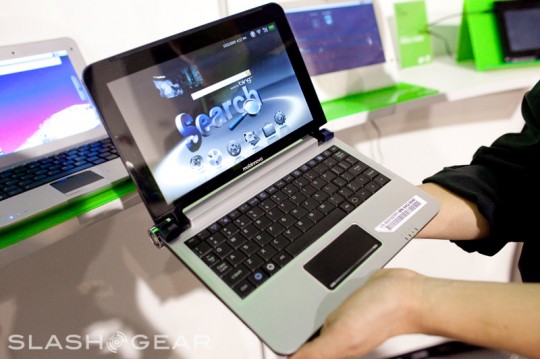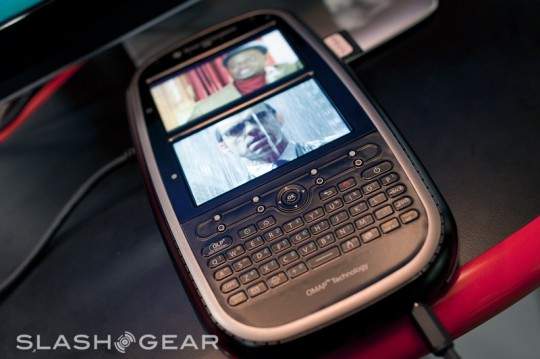Microsoft has evidently been working their socks off with their new mobile OS. They have completely rebuilt Windows Mobile, getting rid of any indication that Windows Mobile ever existed. Therefore, it makes sense that Microsoft has decided to do a little re-branding by calling this new mobile platform “Windows Phone 7 Series”. So what is there to know? Head on past the break for the full break down.
Tuesday 16 February 2010
Monday 15 February 2010
MWC - Maemo plus Moblin Equals MeeGo
One of the biggest announcements so far at MWC has certainly been this one. Nokia is merging Maemo with Intels Moblin OS. This was something no one even saw coming. What this will create is a "software platform that will support multiple hardware architectures across the broadest range of device segments, including pocketable mobile computers, netbooks, tablets, mediaphones, connected TVs and in-vehicle infotainment systems" called Meego. Yes it seems like Nokia and Intel are trying to get this platform into everything they can possibly imagine which is not such a bad idea as both Maemo and Moblin have very good features when mixed together would make an unbelievably amazing platform. It seems like MeeGo will support both x86 and ARM architectures meaning we could find this OS in literally every device if Nokia and Intel play their cards right. We can also be rest assured that the new platform is fully open. Jump the break for the full press release.
Nokia is back in the game with Symbian^3
First of all we all knew Symbian^3 was coming. What we didn't know was how it would look like and how it would do it. Well today we just received some answers at MWC. A video preview is out and waiting and hell its definately is worth it. In fusing ideas from WebOS and Android, Symbian is finally looking like a modern day platform. Symbian now has everything we need, multiple desktops with customizable widgets, visual multi-tasking WebOS style, hardware acceleration making transitions look smooth and the basics which were missed out it Symbian 5th edition such as kinetic scrolling. Also multi-touch has found its way onto the platform with the addition off pinch to zoom. Now lets just hope Nokia has improved the browser as this is looking like a very promising platform now. Check the video after the break.
Labels:
kinectic scrolling,
multitasking,
multitouch,
MWC,
Nokia,
OS,
Symbian^3
Sunday 14 February 2010
MWC - Sony Ericsson going miniture with the Xperia X10 Mini and X10 Mini pro
Sony Ericsson has just announced the double trouble X10 Minis at MWC. The X10 Mini will be coming to market rocking Android 1.6 but hopefully SE will see the light and have a 2.0/2.1 upgrade ready pronto. SE's custom user interface will be slapped ontop of Android to deal with the miniture screen size of 2.5 inches with QVGA resolution. Main features include a 600Mhz Qualcomm MSM7227 processor with the standard Wi-Fi and Bluetooth expected of from all smartphones. The X10 Mini pro is basically an identical device but with the addition of a full QWERTY landscape sliding keyboard. We can expect to see these devices shipping in Q2 if SE doesnt decide to delay them which we've become accustomed to with the original X10. Full press release and specs after the break.
MWC - Samsung Wave with Bada OS
MWC has now started and to kick things off, Samsung have unleashed the Wave running on their brand spanking new Bada OS. Specs wise this device is up thier with the likes of the Nexus one, featuring a 1Ghz processor, 720p HD encoding and decoding and Samsungs own "super AMOLED" screen sized up at 3.3 inches with a resolution of 800 x 480. Unfortunately it seems that there will be no multi-touch supported on this device which is the only real downside to Samsungs latest. Full press release and specs after the break.
Tuesday 9 February 2010
Locus OS concept outed on video
Are you ready to see the future of computing? Well maybe you might want to check Locus OS. Its a concept OS by Barton Smith who has envisioned a future where usability and functionality are one in the same. Just to see what i mean, watch the video down below.
Locus OS Interface from Barton Smith on Vimeo.
Locus OS Interface from Barton Smith on Vimeo.
Friday 5 February 2010
Trojans in Mozilla Firefox add ons
Mozilla has recently admitted that two experimental add ons for its Firefox browser was infected with Trojans affecting Windows users. It is estimated that around 5000 users may be affected by the Trojans which were found in Version 4.0 of Sothink Web Video Downloader and all versions of Master Filer. The add ons in question have now been taken offline. Mozilla has advised infected users to eradicate the Trojans with anti-virus software as uninstalling the add ons will not remove the problem. Mac and Linux users have not been affected.
Source Mozilla blog
Source Mozilla blog
Wednesday 3 February 2010
ARM processors to take 90% of the PC market
ARM CEO, Warren East, is aiming very high it seem for his range of processor technology. He is predicting that 90% of netbooks, which will be the majority of the PC market according to him, will be powered by ARM processors. He may be right about this aswell with the Tegra2 platform looking very promising aswell as its competitor OMAP4 from TI. With Intel and AMD just not able to compete in power efficiency at the moment, it certainly looks like ARM has the advantage as now they have become very able platforms with the ability to playback HD video smoothly. The only disadvantage ARM is facing is the lack of support for Windows. Many users still want to have a Windows user experience as that is what they have become used to and expect on PC's or netbooks. However Microsoft seems to be very reluctant to offer support for the ARM platform which is leaving the gate wide open for Linux based OS's but will users adapt to Linux is another question. Linux has the opportunity to have a head start. Lets hope they make the most of it.
Source SlashGear
Source SlashGear
Monday 1 February 2010
OMAP4 teased just before MWC
The guys over at SlashGear managed to get some hands on time with Texas Instruments latest and greatest processor line due to compete against Snapdragon and Tegra2 in the near future. As we already know, OMAP3 processors are already pretty beastly driving devices like the Motorola Droid. However OMAP4 chipsets can do more than drive one measely smartphone. They have the power to drive no less than three independant displays, one being a pico projector, with each having the ability to be showing different content at the same time. OMAP4 chipsets come loaded with an dual core A9 arm core at its heart with TI specific customizations. Other important things to take note about this chipset is its ability to play and encode 1080p HD video at 30fps aswell as output it via HDMI to a TV while using the two other displays to view other content at the same time. This shows the pure processor power available. So how will this compare to Nvidia's offering you may be wondering. Well TI claim that OMAP4 has “a better video engine than [NVIDIA] do” aswell as more more bandwidth resulting in better multi-tasking capabilities. Most importantly OMAP4 is designed to be a smartphone platform which Tegra2 has still yet expand to. The real showdown will start at MWC.
Source SlashGear
Source SlashGear
Subscribe to:
Posts (Atom)





